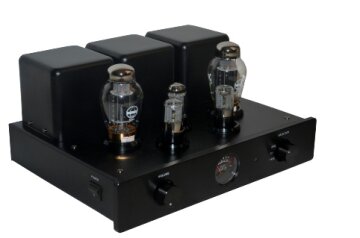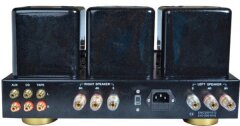Ming Da Piccolo Mk3 Integrated amplifier
Silky smooth and open valve sound, with deep uncoloured bass.
Price: £1199.00

The Piccolo Mk3 is a stereo integrated amplifier designed for those who like the sound quality of a 'Single Ended' power amplifier, but built as an integrated amplifier for simplicity and convenience of use.
The Piccolo employs a pair of the powerful, dynamic and silky sounding KT90 valves running in Single Ended mode to help ensure uncoloured reproduction and true sound.
Driven by 2 x 6N8/6SN7 octal valves plus a smooth valve rectified, with a choke filtered power supply at the pre-amplifier stage, this amplifier is extremely low in hum and noise, even the input valve's heaters are DC powered to give as low a noise floor as possible.
Hand built “point to point” wiring for highest sound quality and employing in-house hand wound output transformers, this amplifier gives a deep, saturation free output of a powerful 18 watts per channel.
It has a total distortion of only 0.8% and an impressive flat frequency response of 18Hz-
Add style and quality to your listening pleasure with this high specification single ended stereo amplifier.
All Ming Da Valve UK amplifiers are covered by a comprehensive 3 year manufacturers warranty, with the exception of valves which are covered for 12 months.
Specifications:
Power output: 18W RMS per channel
Distortion factor: <0.8%
Signal to noise ratio: > 92dB
Frequency response: 18Hz -
Dimensions: L38cm x W33cm x H23cm
Inputs: 3 x RCA.
Outputs: 4ohm and 8ohm speaker output terminals for banana, spade, or bare wire connections.
Review extracts:
See full review at: https://topnewreview.com/ming-da-piccolo/
With its limited output power, it is far better suited to rhythm and blues than drum and bass! Cue up Goldie’s Timeless and you’re struck by all the amplifier’s fine qualities, and then all of its not so fine ones. The opening few phrases are carried with great delicacy and a wonderfully sumptuous tone – sweeter and more mellifluous than you would hear from any transistor amplifier ever made. The lead female vocal is seamless, smooth and tactile. But when the fierce electronic percussion breaks, on a good solid-state amplifier all hell is let loose, but here it is not. The song gathers pace, but you’re aware of compression, and then in comes the electronic bass line, and the Piccolo simply cannot do it justice. It’s a bittersweet experience because you can hear the amplifier deal with the looped hi-hat and snare drum pattern brilliantly; it might be a little less biting than it should, but the timing is superb.
Move to something more sedate and beguiling, and the problems disappear. It’s a revelation, with a breathtaking beauty to Heidi Berry’s dark, sultry voice on Washington Square. The song is moody, atmospheric and has gentle filigree detailing, such as triangles and steel string guitars, sparkling away at the back of the mix. The Ming Da captures it all without so much as blinking; it’s like water off a duck’s back. It even has you gasping at the exotic way that it conveys the rich and resonant piano. On this song the bass line is gentle and doesn’t tax the amplifier much, or throw it off balance like it does with the Goldie track and its swinging dynamics.
The same goes for more uptempo rock tracks like REM’s Welcome To The Occupation. More demands are made of those KT90s and the output transformers downstream of them, but still the amplifier serves a very convincing rendition at modest listening levels. With the help of my reference Cambridge Audio Aeromax 6 loudspeakers’ 90dB sensitivity, it is able to deliver a decently high volume before it runs out of steam. Even when it doss, it does so gracefully, simply not going any louder despite continued clockwise twiddling of the volume knob. Settle the amp a little lower at a good level where it’s not sitting on transients and squashing dynamics, and there’s a wonderfully beguiling rendition of the song. It focuses on the sweet sound of the crashing china boy cymbal of drummer Bill Berry, Michael Stipe’s uniquely gritty, earthy voice and Peter Buck’s plaintive Rickenbacker guitar. Tonally and texturally lovely, it’s almost like it’s telling you that you should forget about absolute power and just get into the groove!Having heard its command, Dave Brubeck’s Take Five quickly finds itself on the turntable. This is a great track, but it can sound oddly flat played on some systems and it does tend to be tough on the amplifiers that can’t keep up. The Ming Da Piccolo has no such problem, playing it like it’s a natural. From the rich golden sheen of the ride cymbal to the full-bodied, woody sound of the piano and the silky, smouldering saxophone, it gives a majestic performance. The recorded acoustic comes over as large, spacious and airy – the speakers seemingly disappearing into space. Inside this is the sound of jazz greats playing great jazz – it is clear that the piano is the most percussive instrument present as it rolls along in a wonderfully fluid way. The syncopation with the drums is magic, and the sax floats and soars above it all.
Again this amplifier is totally blameless, completely outclassing almost all of its price rivals on this sort of material. It sounds so sweet and sumptuous that I find myself wondering why anyone buys transistor amplifiers any more.The answer is soon delivered to me though, when I cue up my prized 1976 pressing of Elgar’s Cello Concerto (Du Pre/Daniel Barenboim/Philadelphia Orchestra). Initially beautiful, giving a string sound as if from heaven itself, when the massed strings come in and the orchestra swells up the sound begins to compress. It’s annoying because – showing many of the outward sonic signatures of a very expensive amp – the Piccolo lulls you into thinking it is a large and powerful performer. Then when musical ‘heavy lifting’ is required, it just falls short, and the only answer is to turn the volume down a little. Part of the ‘problem’ is that it just doesn’t sound ‘cheap’, so you begin to treat it like something costing five times the price, then get frustrated when it isn’t. The cure for this is to stay away from loud, dense programme material, and/or listen less loud, and/or get a smaller room. In fairness, my listening room is relatively big and not everyone would need to ask it to go up to such volumes as me.
OUR COMMENTS:
This is a lovely amplifier, offering a sumtious open sound quality well above its price point when coupled with efficient (90dB+) speakers in a typical domestic sized room. The comments in the review above do make this point clearly and we urge you not to be put off by this, unless your wishing to play your music very loud or have a very large space to fill with music (more than say a 'double sized room' in a typical UK home). We can advise on the correct selection of speakers to suit this amplifier.
In short, this is a terrific integrated amplifier that will never fail to enthrall you.



